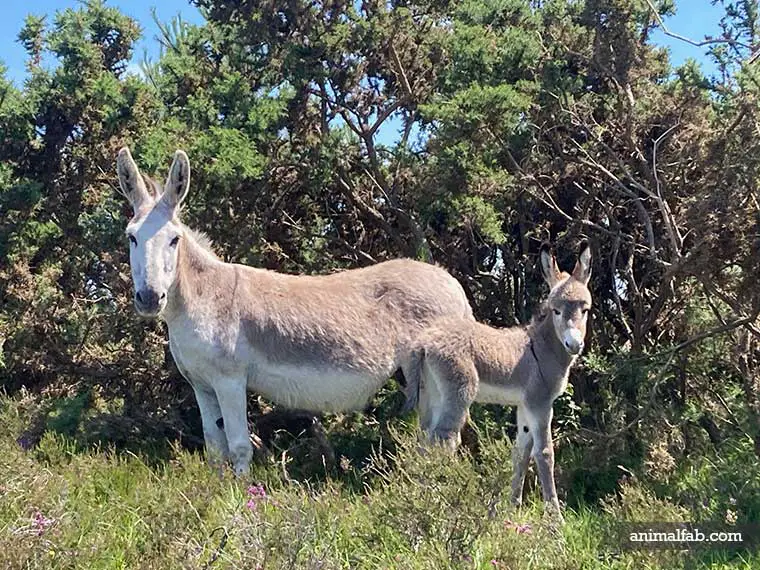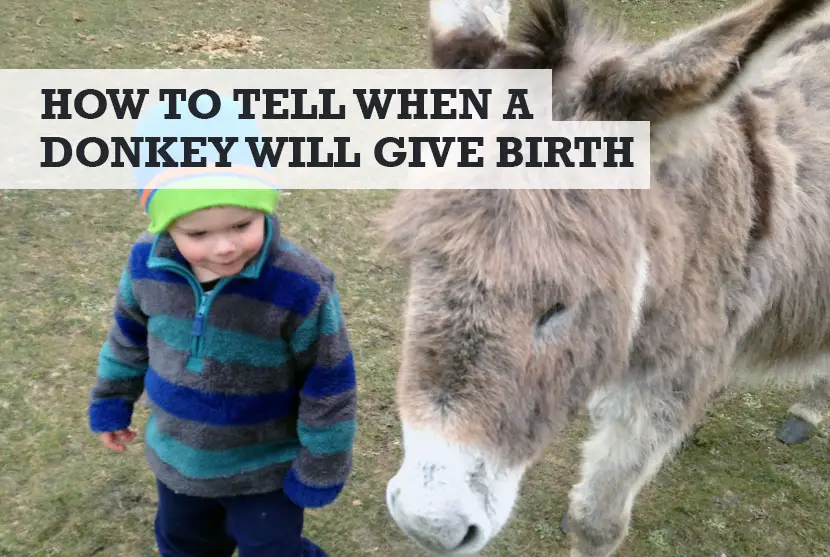In recent years, many people have started to keep donkeys as backyard pets, often in groups. This can result in unexpected pregnancies, but just how do you tell when a donkey is about to give birth and is pregnant. Here are the signs to look out for if your pregnant donkey is very close to the big day.
How to tell when a donkey will give birth? You know will know when a donkey is near to giving birth as the Jenny (female donkey) will become sullen and withdraw from the herd. Her udders and teats will swell, and her hind legs will lose muscle tone in the hours before labor.
If you want to know when a donkey will give birth, then that’s the short answer. But there’s so much more to it. Please do read on if this is your first time owning a pregnant donkey.
How to tell if a donkey is pregnant?
A female donkey is known as a “Jenny”. She can fall pregnant very easily in a herd including males. Often the problem will be that you will not know she is pregnant until she is almost ready to give birth.
That’s why it’s important to know when a donkey is going to give birth, or more to the point, when she’s pregnant… and that might come during the late stages of pregnancy.
Knowing the late signs of Jenny’s pregnancy is important, but you also want to know when she is in the early stages of pregnancy. There is a relatively simple way of telling when donkey is pregnant: she will no longer go into heat.

It might not be easy for you to tell when your donkey has become pregnant until she begins to gain weight around her midsection. But even the gaining of weight can be a difficult aspect of pregnancy to identify, with some donkeys eating more to gain weight.
To further check if a donkey has fallen pregnant, she will gain weight below the stomach as her foal develops. A pregnant donkey will gain weight in strange ways depending on where the baby is sitting within her womb.
Experienced donkey caretakers look for weight gain on one side of their Jenny’s body as a tell-tale sign of a pregnancy.
When do pregnant donkeys start showing?
I have found the signs of pregnancy become more pronounced as foaling draws closer. This is often when some pregnant donkeys start showing more visibily. The pregnancy will continue to bring more weight to the lower midsection of the donkey before moving to the udders and teats.
A sign you should look for that foaling is drawing near is the extreme swelling of the udders and teats. When you are entering the last week of pregnancy, your female donkey will experience severe udder swelling.

The extreme nature of the swelling will make it difficult for you to differentiate between her udders and teats. The last days of her pregnancy will bring the first stages of lactation, with milk oozing from her swollen udders throughout the day.
I have seen the swelling of the udders begin as much as three weeks before labor begins.
Your donkey will isolate herself and become withdrawn
Once the udders of your female donkey begin to swell, she will become sullen and isolate herself from the herd. This is not a bad thing for you because you will want to keep an eye on her as her labor begins.
Around 72 hours before the donkey gives birth, you should put her in her own private area. Your Jenny will now be in discomfort and her pelvic muscles will cramp with contractions. The time is drawing near for foaling, she will be oozing a waxy liquid from her udders that is easy to identify.
Your donkey will enter the final stages of labor within 24 hours of giving birth. At this point she will experience extreme discomfort and can become restless. You may see your mare rolling around to try and ease her discomfort as the north draws near.
The birth can be very fast
Over the last day of pregnancy, you should try and keep a close eye on the donkey to make sure you are available during the birth. You do not want to play too large a role, but you should be there to help if there are problems.
She will often kneel on her front legs and lay her head on the ground, with her hindquarters in the air. This is the first sign that the donkey is about to give birth finally… possibly braying.
The entire process takes around 40 minutes to complete. Most donkeys give birth laying down, but some will stand to ease their discomfort. If she is standing when giving birth, you can stand and catch the foal when he is free from the mare.
One the foal has been born, the mother will smell her in order to remember the scent. She does this by baring her teeth, drawing the scent into the mouth. She will then be able to easily differentiate her foal from the herd.
How to care for a pregnant donkey about to give birth
Most donkeys will give birth without any complications. Your role will be to catch a falling foal and wipe any mucus away from the face.
But for most donkey owners, standing back and watching the miracle of birth is their sole role. The umbilical cord will work itself free over time and does not require your assistance for most births.
Handy Hint: Here’s a list of foods that are bad for donkeys and they should never, ever eat, no matter what the circumstances.
Post birth care
After the foal has been born, you should remain with your donkey to ensure the placenta is passed within one hour.
If the placenta is not passed, you should call your vet for emergency assistance. Almost immediately, she will circle her foal and guide it to an udder for her first feed.
How long is a donkey pregnant?
How many months is a donkey pregnant will range between 11 and 14 months. After you notice your donkey is pregnant, you should not expect a speedy pregnancy to take place.
Keeping track of when your mare is in heat will help you to calculate when foaling will take place.
Conclusion
In the last few years, donkeys have become more popular as pets. Donkeys are social and loving animals that offer their owners a loyal companion through the years.
If you expand your group of donkeys, known as a drove, you could see a pregnancy occur in a short time.

